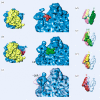The translation elongation cycle-capturing multiple states by cryo-electron microscopy
- PMID: 28138066
- PMCID: PMC5311924
- DOI: 10.1098/rstb.2016.0180
The translation elongation cycle-capturing multiple states by cryo-electron microscopy
Abstract
During the work cycle of elongation, the ribosome, a molecular machine of vast complexity, exists in a large number of states distinguished by constellation of its subunits, its subunit domains and binding partners. Single-particle cryogenic electron microscopy (cryo-EM), developed over the past 40 years, is uniquely suited to determine the structure of molecular machines in their native states. With the emergence, 10 years ago, of unsupervised clustering techniques in the analysis of single-particle data, it has been possible to determine multiple structures from a sample containing ribosomes equilibrating in different thermally accessible states. In addition, recent advances in detector technology have made it possible to reach near-atomic resolution for some of these states. With these capabilities, single-particle cryo-EM has been at the forefront of exploring ribosome dynamics during its functional cycle, along with single-molecule fluorescence resonance energy transfer and molecular dynamics computations, offering insights into molecular architecture uniquely honed by evolution to capitalize on thermal energy in the ambient environment.This article is part of the themed issue 'Perspectives on the ribosome'.
Keywords: free-energy landscape; mRNA–tRNA translocation; molecular machines; single-particle reconstruction.
© 2017 The Author(s).
Figures


References
-
- Frank J, Spahn CMT. 2006. The ribosome and the mechanism of protein synthesis. Rep. Prog. Phys. 69, 1383–1417. (10.1088/0034-4885/69/5/R03) - DOI
Publication types
MeSH terms
Grants and funding
LinkOut - more resources
Full Text Sources
Other Literature Sources
Miscellaneous
